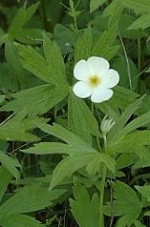 A North American native of moist meadows, streams banks, and open woods, this herbaceous perennial is a member of the buttercup family, Ranunculaceae, that also includes delphinium, clematis, and hellebore. It grows 1-2″ tall and has light green leaves that are 6-8″ long and deeply cut into 5-7 toothed parts with hairs on the undersides. The 1-2” wide white flowers appear in loose clusters of 3-5 on slender stems in spring. The flowers lack petals but have 4-5 showy white sepals surrounding a golden center of stamens. Meadow anemone is a vigorous grower in its natural environment and can be invasive but is better behaved in drier sites. It naturalizes easily and is especially attractive when allowed to form a large colony in wildflower or native plant gardens. The genus name, Anemone, is probably a corrupted Greek loan word of Semitic origin referring to the lament for the slain Adonis or Naaman, whose scattered blood produced the blood-red Anemone coronaria. The specific epithet, canadensis, refers to the natural habitat of the plant in North America including northeastern US and Canada.
A North American native of moist meadows, streams banks, and open woods, this herbaceous perennial is a member of the buttercup family, Ranunculaceae, that also includes delphinium, clematis, and hellebore. It grows 1-2″ tall and has light green leaves that are 6-8″ long and deeply cut into 5-7 toothed parts with hairs on the undersides. The 1-2” wide white flowers appear in loose clusters of 3-5 on slender stems in spring. The flowers lack petals but have 4-5 showy white sepals surrounding a golden center of stamens. Meadow anemone is a vigorous grower in its natural environment and can be invasive but is better behaved in drier sites. It naturalizes easily and is especially attractive when allowed to form a large colony in wildflower or native plant gardens. The genus name, Anemone, is probably a corrupted Greek loan word of Semitic origin referring to the lament for the slain Adonis or Naaman, whose scattered blood produced the blood-red Anemone coronaria. The specific epithet, canadensis, refers to the natural habitat of the plant in North America including northeastern US and Canada.
Type: Herbaceous perennial
Bloom: Single white flowers 1-2” across in late spring to early summer on the top of erect stems.
Foliage: Deeply cut dark green basal leaves
Size: 1-2’ H x 2-2.5’ W
Light: Full sun to part shade; needs more water in full sun
Soil: Humus rich, medium to wet
Hardiness: Zones 3-9
Care: Low maintenance except where invasive
Pests and Diseases: None of significance
Propagation: Seeds that ripen in early summer, division from May to September
Companion plants: Blue flag (Iris versicolor), dogbane (Amsonia tabernae-montana), meadowsweet (Spireaea latifolia), Virginia bluebells (Mertensia virginica), Jacob’s ladder (Polemonium reptans), old fashioned bleeding heart (Dicentra spectabilis), Solomon’s seal (Smilacina racemosa), ferns, columbine (Aquilegia spp.) and satin flower (Sisyrinchium douglasii)
Comment: Deer tolerant.
